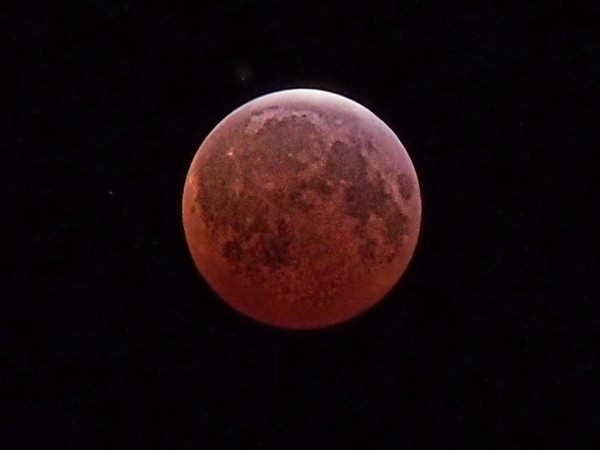Blue Skies and Red Sunsets
By John Palka — Posted March 20, 2016
Sunny skies bring a special delight to most of us, especially in regions where cloudiness is a common experience. We enjoy the bright colors, and the feel of the Sun’s radiant energy on our skin. Nature draws us outside with a special insistence. The sky is a powerful presence, and its blue color is an integral part of our experience. But what is the sky, really, and why does it look blue while the Sun looks golden during the day and reddish at dawn and dusk?
To many ancients, the sky was some sort of structure. In the West, this idea was epitomized by Ptolemy’s scheme in which the Earth was the center of the universe, and was surrounded by various spherical shells that were the abode of the planets, the Sun, and, in the outermost one, the stars.
In many other systems of thought, the Sun was a deity. To the Greeks, it was Apollo and especially Helios. In the Indian tradition, it is Surya. Both Helios and Surya were believed to drive the chariot of the Sun across the skies. One of the most famous hymns of the ancient Rig Veda salutes the Sun thus:
The Sun has harnessed the seven shining daughters of his chariot [meaning seven horses].
He advances, driving his well-trained team.
Looking upon the loftier light above the darkness
We have come to Surya, God among the gods, the highest light.
The modern scientific view is profoundly different. We understand the Sun, not the Earth, to be the center of the solar system. We understand the Sun to be a star whose light energy sustains life on Earth, and to be just one among countless stars in the Universe. And we understand the sky to be not a structure, nor a place, but a flood of blue light that arises because of the way the light coming to us from the Sun interacts with the molecules of the atmosphere that surrounds our planet. Not only that, we understand the red and gold light of dawn and sunset to be a consequence of exactly the same interaction.
Here, then, is how scientists think about the sky today. The Sun emits a vast spectrum of electromagnetic radiation, ranging from gamma rays with minuscule wavelengths to radio waves with wavelengths measured in kilometers. The visible spectrum of our daily experience is only a tiny sliver of this vast range, but it (plus UV and infrared) is where the Sun’s energy output is concentrated. Our vision is well matched to solar energy – the wavelengths at which the Sun emits the most energy include the ones we see the best.
Before reaching the surface of the Earth, the Sun’s radiation passes through the atmosphere and encounters the diverse gas molecules of which the atmosphere is composed: about 78% nitrogen, 21% oxygen, and 1% quantitatively minor components. Among the latter are carbon dioxide and methane, both of which are important in generating the greenhouse effect that is so much in the news these days, and ozone that provides the Earth’s crucial shield against UV radiation. Water vapor in the atmosphere is also important in many ways. For physical reasons it is measured separately and not included in these percentages.
On its way through the atmosphere, the light of the sun interacts with the dispersed gas molecules. These interactions regulate which wavelengths reach the Earth’s surface the best. For example, gamma rays, X-rays, and especially UV (wavelengths that would be highly damaging or even lethal to life) are strongly absorbed by the atmosphere. In contrast, visible light, as well as selected wavelengths in the infrared, pass with little attenuation through so-called atmospheric windows. The rest of the infrared, and longer wavelengths in the microwave range, are absorbed, until we get to the gigantic radio waves that pass freely. You can find a simplified diagram of this relationship here: http://csep10.phys.utk.edu/astr162/lect/light/windows.html
So, one process that influences the array of wavelengths originating from the Sun that actually reaches the surface of the Earth is wavelength-selective absorption in the atmosphere. A second process that affects incoming light is scattering. It is scattering that gives rise to our magnificent blue skies and gloriously red sunrises and sunsets. The process is called Rayleigh scattering, after the 19th century English physicist who first worked it out. Here is a simplified version of the relevant principles.
- Incoming light energy interacts with a scattering molecule in such a way that it is immediately re-emitted without any change in wavelength.
- The incoming wave initially comes from the direction of the Sun, but it can be re-emitted in any direction, though not equally well.
- The effectiveness of this process depends on the quantitative relationship between the wavelength of the light and the size of the scattering molecule. For molecules of a given size, such as nitrogen or oxygen, short wavelengths are scattered much more effectively than are long ones.
Here are the consequences of these principles. You might enjoy this web-based presentation of the same ideas: http://www.atoptics.co.uk/atoptics/blsky.htm .
- Blue wavelengths are preferentially scattered. Nitrogen and oxygen molecules, by far the most abundant constituents of the atmosphere, are very small. For this reason they preferentially scatter short wavelengths. All wavelengths of the visible spectrum are scattered, but those at the blue end are scattered about five times more effectively than are those at the red end.
- In Rayleigh scattering, light is scattered in all directions. As seen from the Earth, the Sun is a tiny light source. It occupies only a very small percentage of the sky. Hence, all its light reaches the Earth effectively from a single direction. However, once a wave has been scattered, it may travel in any direction—forward, back, up, down, or sideways—though Rayleigh scattering does not work equally well in all directions around the scattering molecule. Subsequently the scattered wave can encounter another nitrogen or oxygen molecule and be scattered again, in any direction. This process can be repeated many times. No matter where in the sky we look, some rays will be emitted from their final scattering event in the direction of our eyes. That is why we see blue sky in all directions. If there were no scattering, we would see the sky as black. In fact, if we go high enough above the surface of the Earth, where there is little or no air to scatter light, the sky does look black.
- Rayleigh scattering explains red sunsets as well as blue skies. When we look at the Sun, which is much brighter than the surrounding sky, we see it as yellowish during the day and ever redder as it sinks toward the horizon. It is so bright because we see its rays directly, without the need for rare scattering events to bring its light to our eyes. It has a warm appearance, however, because at least some of the blue light has been preferentially scattered out of the way, leaving relatively more of the longer wavelengths to be captured by the cells in our eyes and thus experienced subjectively as a warm color. When the Sun approaches the horizon, at dawn and at dusk, it looks much redder than at mid-day. The principal reason for this appearance is that the path of the Sun’s light through the atmosphere on its way to where we are watching is longer than when the Sun is overhead. Therefore, the light encounters more scattering molecules on its way to our eyes, and more of the blue light relative to the red light is scattered. This leaves the remaining light redder, and gives us our treasured sunrises and sunsets. Their detailed appearance is also influenced by a number of other atmospheric factors, including pollution particles from various sources.
Here is another example in which the phenomenon of selectively scattered light is manifested. If you were up at the right times in 2015, you had four chances to see a total eclipse of the Moon. And if you looked carefully, or took photographs, you could see that during totality the Moon was not its usual fairly neutral color but rather was of an intensely warm hue, often described as blood red. To all who watched, it was an exhilarating experience.
Here is how it came about. During an eclipse, the Sun, Earth, and Moon are precisely lined up, in that order. Inasmuch as the Earth is situated between the Sun and the Moon, it places the Moon in full shadow. Thus, the Moon should be black and invisible against the night sky. However, the Earth’s atmosphere acts like a lens and bends the Sun’s rays slightly inward, so that instead of missing the Moon altogether some of them strike its surface. From the Moon’s surface, a small fraction of this sunlight is reflected back to us, so we can see it, albeit faintly. And why is it red? As sunlight takes its glancing path through the Earth’s atmosphere on its way to the Moon, its blue components are scattered particularly well, in the same way as at sunrise and sunset. This leaves predominantly the warm colors to pass through, reach the Moon, and be reflected from it back to the Earth. That’s why we see the Moon hanging red in the sky. (You can find some helpful illustrations and explanations here: http://www.mreclipse.com/Special/LEprimer.html).
I find this inspiring. A single basic mechanism—wavelength-dependent scattering in the Earth’s atmosphere—explains three apparently disparate phenomena: the blue color of the sky, the reddish color of sunrises and sunsets, and even the magical red of the Moon during a total eclipse. To me, this is an example of science at its most profound, showing us the underlying unity of the natural world. It helps us understand John Muir’s famous statement in My First Summer in the Sierra in a new way:
When we try to pick out anything by itself, we find it
hitched to everything else in the universe.
Next time you go out for a walk, seek out at least one example of your own of this statement of interconnectedness. It needn’t be cosmic. Just start with something you observe, and see where your thoughts lead you.




Great posting Johnny — wonderful exposition — thanks for your efforts..!
Thank you, Marty. I find it an exhilarating subject, so I’m particularly glad that my exposition worked for you.
Johnny, This is a great article! Wish they had made it so simple and clear when I was a grad student at Caltech!
Wow! Thanks for such a fine compliment!